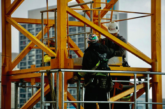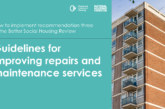Jan Taranczuk, Strategic Housing Advisor at fire suppression specialists Plumis, discusses what new fire safety rules will mean for social landlords.
New fire safety regulations are bringing in a raft of extra requirements and responsibilities for housing providers, in a bid to better protect residents living in high-rise blocks. In addition to the Building Safety Act, the Government has introduced the Fire Safety (England) Regulations 2022 as part of its ongoing response to the Grenfell Tower tragedy and the resulting inquiry’s recommendations.
With the new regulations coming into force in January 2023, social landlords need to take stock of these latest reforms and the implications for their organisations.
Key changes
The changes include:
- The need to provide residents with fire safety instructions and information about the importance of fire doors, in all multi-occupied residential buildings.
- Annual checks of flat entrance doors and quarterly checks of all fire doors in communal areas, in residential buildings over 11 metres high.
- Monthly inspections of lifts and fire fighting equipment.
- The need to share information (including building floor plans and details of high-rise blocks’ external wall design and materials) with fire and rescue services which will help them respond in case of a fire.
There are also requirements around installing secure information boxes in buildings, along with wayfinding signage which is visible in low light or smoky conditions.
Housing providers must make sure they have plans in place to action these legislative changes. Perhaps most importantly, this should include a resident engagement strategy to ensure they are informing everyone about how to keep themselves and their neighbours safe.
The regular inspections of fire doors and firefighting equipment will need to be scheduled in, as well as robust processes to accurately record such checks, in order to demonstrate compliance with the regulations and promptly action any remedial work necessary.
Beware complacency
The new rules are to be welcomed as a further step forward in improving fire safety for residents living in high-rise flats. However, having implemented these changes, it is vital that housing association boards and leadership teams guard against complacency.
The Building Safety Act stipulates that, once the ‘accountable person’ has demonstrated that their high-rise residential building complies with the law, the Health and Safety Executive will issue a Building Assessment Certificate confirming that the property is safe for occupation.
But, while this certificate proves that steps have been taken to reduce the opportunity for a fire within the building to spread, these measures do nothing to actually reduce the risk of fires occurring in the first place.
The danger is that residents, along with their landlords, will assume that they are effectively safe from fire in such a building but people’s behaviour will, inevitably, remain a crucial consideration. Hence, as well as making these necessary statutory changes, housing providers must also maintain continuous messaging to their residents (without becoming so repetitive it begins to be ignored) around fire prevention and safety awareness.
So, for example, they might use newsletter articles, website blogs or social media posts reminding customers of basic (but sometimes overlooked) advice such as never leaving candles or cooking unattended, running washing machines overnight or smoking in bed.
Evolving fire risks
Such messaging should also reflect a recognition of emerging fire safety challenges, including the potential dangers posed by charging the UK’s growing number of electric bicycles, scooters and even cars.
Earlier this year London Fire Brigade revealed that it had seen a ‘huge spike’ in fires involving e-scooters and e-bikes, with its crews attending over 70 such fires in 2021. They said most fires relating to personal vehicles happened in homes and were often caused when charging their batteries.
Just this summer the brigade issued an urgent safety warning, after an e-bike battery failure caused a large fire in a west London tower block, urging people not to charge bikes while they were asleep or to store them in communal areas.
An electric bike is also believed to have started a fire at a Bristol tower block in September this year, when a man tragically lost his life after falling from a window as he tried to escape the blaze. E-scooters have even been banned on London’s public transport after some with faulty batteries caught fire in stations and trains on the Underground.
So, while engaging with residents is intrinsic to the success of new fire safety legislation in achieving its life-saving aims, housing providers need to ensure their fire prevention measures and messages keep pace with the changing risks they seek to combat.
Cycle of change
Of course, the latest regulations should come as no surprise. With the spotlight very much cast upon fire safety issues in recent years, social landlords all over the country have been preparing themselves for what to expect next.
But it is important we recognise that change is a cycle. Having implemented changes, we then have to start the process again, monitoring our progress and making further changes in order to continuously improve the way we do things.
We need to re-assess organisational cultures and mindsets within the social housing sector so that it becomes universally appreciated that fire safety changes will never be completed — they must always be an ever-evolving aspect of a landlord’s responsibilities and operations.
Leadership teams should be alive to this, encouraging their boards to constantly challenge with ‘what if?’ questions, while having the confidence in their fire safety staff to know they will be able to provide the answers.
On top of the necessary actions to comply with these new rules, everyone involved — from the housing officer who regularly visits residents to the board member who combs through regulatory reports — must avoid complacency and continually ask themselves ‘Are we doing enough?’













